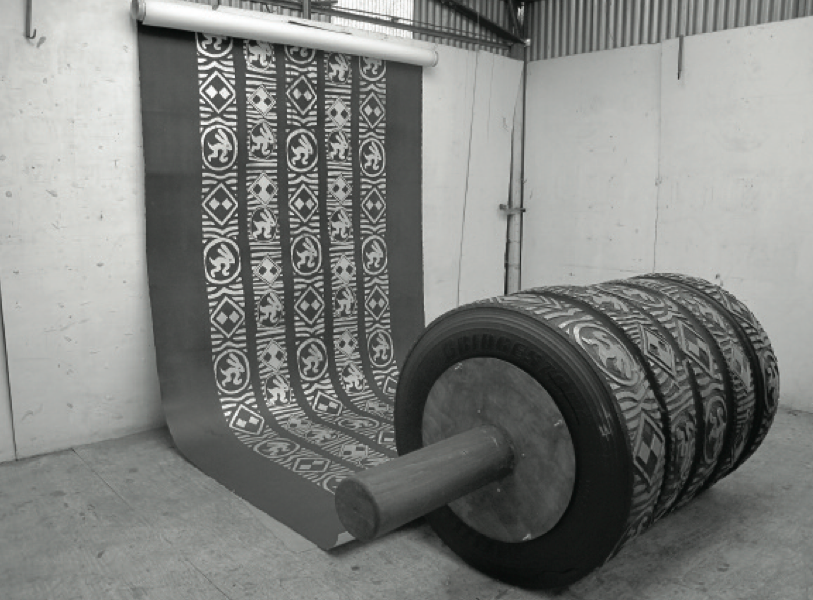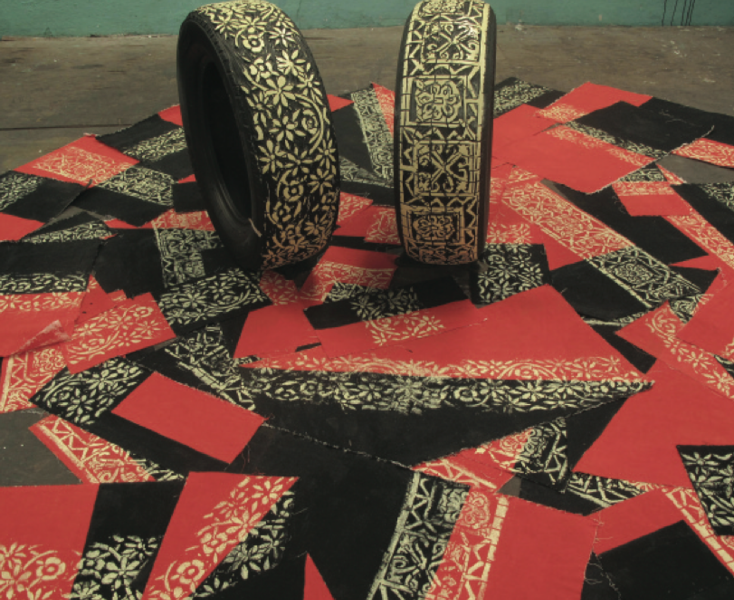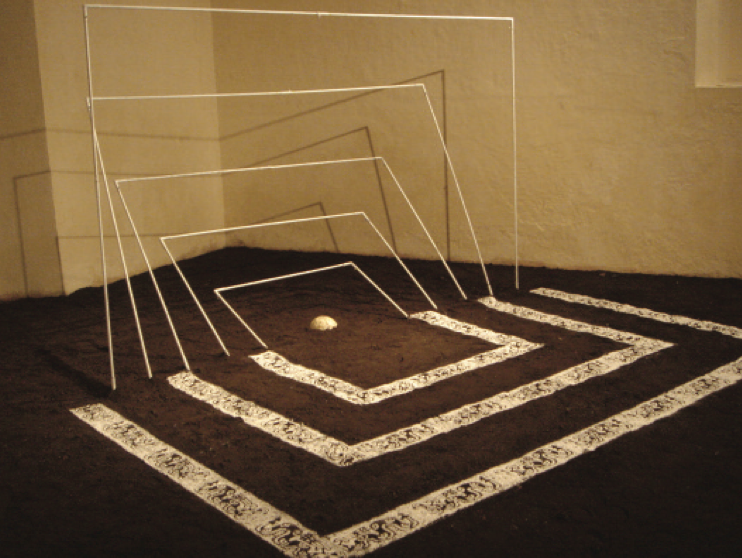Betsabeé Romero
Under the Gaze of Memory
The Mexican visual artist Betsabeé Romero1 expresses herself through different artistic mediums – painting, photography, collage, serigraphy, sculpture – but her favorite material is the car and all the parts and accessories that constitute it. Since the beginning of her career, the artist has resorted to non-conventional supports – textiles, plastics, braided or knitted rush mats – because painting is the art of galleries, the art that always attracts the same public: museum-goers. For Romero, art is not a separate world functioning behind closed doors, since it must play a genuine social role in the human community. The artist becomes the witness and the critical eye of the society in which he/she lives. An awakener of consciences through her installations that commemorate the fate of immigrants, and at the same time, the guardian of memory on account of her work on the pre-Columbian past, Betsabeé Romero presents her works as if they were mirrors helping us to take a better look at reality. For this reason, her visual universe places the viewer in a situation of amazing familiarity reflecting both our everyday life and environment, and the social problems that can be found in modern society.

A popular and traditional visual vocabulary
Betsabeé Romero’s aesthetic vocabulary is the vocabulary of the street and of the people, of a collective memory to which every Mexican, from the richest to the poorer, is sensible. All the objects she creates or incorporates in her artworks are the symbols of a national culture: the roses that adorn the dress of Our Lady of Guadalupe are painted on the Ford Victoria exhibited at the In’Site97 Biennial, Ayate Car (1997); the famous Volkswagen nicknamed “Vocho” is submerged in a fountain in Colonia de la Condesa, in the installation Todo lo que brilla no es verde (2007); the baked clay of Oaxaca engraved with pre-Columbian drawings marks the path of the emigrants trying to cross the border in the work Memoria atropellada (2001). These popular and recognizable Mexican references also incorporate pre-Columbian elements as latent survivors in contemporary Mexican culture: the petate, the braided rush mat on which the Indians sleep, but which also serves as shroud and which the artist utilizes to denounce consumer society when she covers a car exhibited opposite an American scrap car, El Petate justiciero (2001); the tamal, a dish based on cornflour steamed in corn leaves, which the artist transforms into an artwork when she exhibits it in the street, El que nace para tamal... del cielo caen hojas (2000); the car tire is the fundamental element of urban culture to which the artist makes reference in Juego de pelota (2000)2. Each of these elements is integrated in the artist’s creations or constitutes their support, combining traits from popular culture and pre-Hispanic culture, highlighting the surviving traits of each of them in the other, giving birth to the mestizaje (racial and cultural mixture) that was the foundation of Mexicanness. The artwork features a fusion of the temporal strata, which make indigenous references confront popular urban elements, reflecting at the same time the depth and the diversity of the national culture. Betsabeé Romero’s creations are like so many mirrors of society, which leads Osvaldo Sánches to express that “far from any mystical intention, the actual theme addressed by these works may be the collective memory.”
Art and memory
While the artist does not hesitate in drawing on the sources of artisanal and popular traditions in her artistic choices, her works are eminently modern, no doubt because the car and the car culture are the bases for Betsabeé Romero’s approach, and they structure the ensemble of her works. The greatest paradox in this is that the artist employs the symbol of a modernism that thinks in terms of progress, advancement or speed to give birth to a past that does not cease to exist. In fact, the wheel for which the artist has an affinity, only advances to highlight the past. Thus, at the 2004 Havana Biennial, the artist rolled tires engraved with pre- Columbian motifs, whose tracks marked the whole city, in order to bring to mind the presence of an ancient culture, occult but latent, banal but omnipresent in everyday life. On the other hand, it is not by chance that numerous titles of works make reference to memory: Llanta para pavimento con memoria III (2001), Recordando el camino hacia El Dorado (2004). The whole purpose of Betsabeé Romero’s wheel is its rolling towards the past, not out of an affinity for the folkloric, but to restore to the surface the past which has been the founder of the collective memory. Romero’s œuvre goes back in time; it goes against the current to reveal to us a history conceived not in its linear development, but in a cyclic way. In this vision of time akin to Walter Benjamin’s or to that of art historian Aby Warburg, objects disappear, they emerge again, they are present on the surface, like History’s ghosts. Such is the case of the artist’s pre-Columbian motifs, which do not cease to reappear from one work to the next, from one city to the next, in the manner of an obsession.
A Committed Art
In this permanent “act of resistance”4 that its artistic approach represents, her body of work does not cease to denounce the speed that modern society preconizes, because this perpetual search generates oblivion in man; oblivion of his culture, of his roots, and in fact, of his identity. It is for this reason that Betsabeé Romero’s creations partake of the nature of commemoration; they have to do with recalling the memory of what no longer exists, both in what respects the past and in what respects men. In this regard, her work is committed, particularly when the artist evokes the fate of emigrants. Thus, the installation Camposanto (2006), may be perceived as an ex voto that commemorates death, and at the same time, the existence of individuals who, without this artistic oeuvre, would have remained unkown and without a grave. Art will therefore consecrate an identity and a dignity for them. Betsabeé Romero’s oeuvre reveals itself to be a committed work, which combines local references with the aim of reflecting the mechanisms of globalization in order to better denounce its dangers.
To reveal, to denounce, to give birth, to discover: this vocabulary of “revelation” illustrates the social role that the artist attributes to the creative artist and explains the recourse of the crystals, the mirrors, the eyeglasses, the windshields and other rear-view mirrors adorned with pre-Columbian motifs, like the photographs and the video of the “Vocho”, from the series Del otro lado del espejo. The windows of the Vocho, which symbolizes modern Mexico, are adorned with pre-Columbian floral drawings. While the automobile drives round the Zócalo, a place that is eminently symbolic of the city’s past, the viewer sees contemporary Mexico through the leveling view of its indigenous and mestizo history, which lends it this very particular identity. While all these accessories are reflected in the automobile culture, they represent, above all, this reality that the artist makes sure to show us, this transparency between the world and us that Betsabeé Romero wishes to establish through her works. Like her installation featuring eyeglasses tattooed with drawings of indigenous textile patterns, Tramo de lo evidente (2006) indicates, the artist’s aim is to open our eyes regarding a present marked by the stamp of the past. Her work reminds us of the fact that amidst the loss of references that a globalized world generates, a local identity is as ineluctable as it is necessary.






